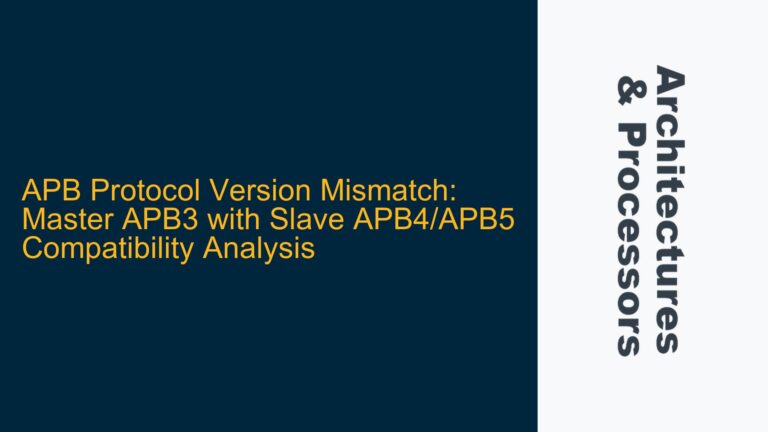ARM CHI Architecture and Home Node (HN) Channel Dependency Ambiguity
The ARM Coherent Hub Interface (CHI) architecture is a sophisticated protocol designed to facilitate efficient communication between various nodes in a system-on-chip (SoC). These nodes include Request Nodes (RN), Subordinate Nodes (SN), and Home Nodes (HN). Each node type has specific roles and responsibilities, and the CHI specification meticulously outlines the channel dependencies for RN and SN to ensure proper prioritization and data coherence. However, the specification does not explicitly define channel dependencies for Home Nodes (HN), which act as intermediaries between RN and SN. This omission raises critical questions about how HN should handle channel dependencies, whether they should inherit dependencies from RN and SN, and whether arbitrary channel dependencies in HN designs could lead to operational inconsistencies or failures.
The CHI protocol defines several channels for communication, including Request (REQ), Response (RSP), Data (DAT), and Snoop (SNP) channels. Each channel serves a distinct purpose: REQ channels carry requests from RN to HN, RSP channels convey responses from HN to RN, DAT channels transfer data between nodes, and SNP channels handle snoop requests and responses. The prioritization of these channels is crucial for maintaining system performance and coherence. For instance, RN prioritizes RSP and DAT channels over SNP and REQ channels, while SN prioritizes inbound DAT messages followed by inbound REQ messages. These dependencies ensure that critical operations like data responses and snoop requests are handled promptly, preventing bottlenecks and ensuring data integrity.
However, the absence of explicit channel dependency rules for HN introduces ambiguity. HN plays a pivotal role in the CHI architecture, acting as a central hub that manages requests, responses, and data transfers between RN and SN. Given its intermediary position, HN must handle messages from multiple channels simultaneously, making channel prioritization essential for maintaining system coherence and performance. Without clear guidelines, designers may implement arbitrary channel dependencies in HN, potentially leading to suboptimal performance, data coherence issues, or even system failures.
Memory Coherence Risks and Prioritization Logic Gaps in HN
The lack of explicit channel dependency specifications for HN can lead to several potential issues, primarily revolving around memory coherence risks and gaps in prioritization logic. One of the most significant risks is the violation of memory coherence protocols. In a multi-node system, maintaining memory coherence is paramount to ensure that all nodes have a consistent view of shared data. The CHI protocol relies on precise channel prioritization to achieve this coherence. For example, when an RN sends a read request to HN, the HN must prioritize the corresponding RSP and DAT messages to ensure that the RN receives the correct data promptly. If HN does not adhere to the same prioritization rules as RN and SN, it may inadvertently delay critical messages, leading to stale data or incoherent memory states.
Another potential issue is the creation of deadlocks or livelocks due to improper channel prioritization. Deadlocks occur when two or more nodes are waiting for each other to release resources, resulting in a standstill. Livelocks, on the other hand, occur when nodes are continuously retrying operations without making progress. In the context of CHI, if HN does not prioritize channels correctly, it may cause RN and SN to wait indefinitely for responses, leading to deadlocks. Similarly, if HN prioritizes less critical messages over more critical ones, it may cause RN and SN to repeatedly retry operations, resulting in livelocks.
The absence of explicit channel dependency rules for HN also introduces gaps in prioritization logic. While RN and SN have well-defined prioritization rules, HN must handle messages from both RN and SN, making its prioritization logic more complex. Without clear guidelines, designers may implement prioritization logic that conflicts with the rules defined for RN and SN. For example, if HN prioritizes REQ messages over RSP messages, it may delay critical responses, leading to performance degradation. Similarly, if HN does not prioritize SNP messages correctly, it may fail to handle snoop requests promptly, leading to data coherence issues.
Implementing Derived Channel Dependencies and Synchronization Mechanisms
To address the ambiguity surrounding HN channel dependencies, designers can derive channel dependencies from the rules defined for RN and SN. Since HN acts as an intermediary between RN and SN, it is reasonable to assume that HN should adhere to similar prioritization rules. For example, HN should prioritize RSP and DAT messages over SNP and REQ messages, similar to RN. Additionally, HN should prioritize inbound DAT messages followed by inbound REQ messages, similar to SN. By deriving channel dependencies from RN and SN, designers can ensure that HN maintains consistent prioritization logic, preventing memory coherence issues and performance bottlenecks.
Implementing derived channel dependencies requires careful consideration of the interactions between RN, SN, and HN. Designers must ensure that HN’s prioritization logic aligns with the rules defined for RN and SN. For example, when HN receives a read request from RN, it should prioritize the corresponding RSP and DAT messages to ensure that RN receives the correct data promptly. Similarly, when HN receives a snoop request from SN, it should prioritize the corresponding SNP messages to ensure that SN receives the snoop response promptly. By aligning HN’s prioritization logic with RN and SN, designers can maintain system coherence and performance.
In addition to deriving channel dependencies, designers should implement synchronization mechanisms to ensure that HN handles messages correctly. One such mechanism is the use of data synchronization barriers (DSBs) and cache management instructions. DSBs ensure that all preceding memory operations are completed before proceeding to the next operation, preventing out-of-order execution that could lead to data coherence issues. Cache management instructions, such as cache invalidation and cleaning, ensure that the cache remains consistent with the main memory, preventing stale data from being accessed.
Another synchronization mechanism is the use of message queues with priority levels. By assigning priority levels to different message types, designers can ensure that HN processes critical messages first. For example, RSP and DAT messages can be assigned higher priority levels than SNP and REQ messages, ensuring that HN processes responses and data transfers promptly. Similarly, inbound DAT messages can be assigned higher priority levels than inbound REQ messages, ensuring that HN processes data transfers before handling new requests. By implementing message queues with priority levels, designers can enforce channel dependencies and prevent prioritization conflicts.
To further enhance synchronization, designers can implement flow control mechanisms to regulate the rate at which messages are processed. Flow control mechanisms, such as credit-based flow control, ensure that HN does not become overwhelmed with messages, preventing bottlenecks and ensuring smooth operation. In credit-based flow control, each node is allocated a certain number of credits, which represent the number of messages it can send. When a node exhausts its credits, it must wait until it receives more credits before sending additional messages. By regulating the flow of messages, designers can prevent HN from being overloaded, ensuring that it processes messages efficiently.
In conclusion, the absence of explicit channel dependency specifications for HN in the ARM CHI architecture introduces ambiguity and potential risks, including memory coherence violations, deadlocks, and prioritization logic gaps. To address these issues, designers can derive channel dependencies from the rules defined for RN and SN, ensuring that HN maintains consistent prioritization logic. Additionally, designers should implement synchronization mechanisms, such as data synchronization barriers, cache management instructions, message queues with priority levels, and flow control mechanisms, to ensure that HN handles messages correctly and efficiently. By addressing these challenges, designers can ensure that HN operates reliably and efficiently, maintaining system coherence and performance in ARM CHI-based systems.






